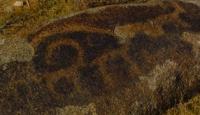You are here
Petroglyphs of Ayrymach-Too.

Trips to the monuments of Kyrgyzstan.
“The distance of time’s separation brings us remnants of memories so ancient that most are lost in the mists of illusion…”
A.J. Vosse.
Archaeological journey Kyrgyzstan - Uzbekistan.
The site is Ayrymach-Too (Surottuu-Tash) located 9km north-west of Sulayman-Too within the territory of the Kyzyl-Kyshtak village in the Kara-Su district of the Osh Province, near the state border between Kyrgyzstan and Uzbekistan.
Geographic coordinates: NL 40 34 44.2, EL 72 43 54.4. The Ayrymach-Too mountains consist of limestone rocks. The south-western spur of the mountain –Orto-Too (2,700m long)- consists of five peaks stretching along a north-east line.
The first peak – Kambar-Ata- is in Uzbekistan and is a mazar or holy place. Two other peaks are known amidst locals as 01 and 02, from the exploratory work of geodesists in the past. The third peak, called Surottuu-Tash, is well-known in the literature along with Ayrymach-Too.
Most petroglyphs belong to this mountain. The fourth, nameless, peak is somewhat isolated from the others and divided from them by an unpaved road. The first peak (01) is 988.2m above sea level. Twenty-eight drawings of horse, mountain goats, snakes, deer, wolf or dog, as well as feline predators were found there.
Some are well-preserved while others are barely noticeable. They are located in several groups on the southern and southeastern slopes. A cultic horizontal slab (5x6m) with traces of polishing is in the middle of the southeastern slope. Stairs hacked out of the rock lead to the slab.
There is a similar slab (6 x 8m) with two lateral and one transverse grooves on the northern part of the peak below the ridge. Cup holes for oblation with a diameter of 8 - 25cm with traces of abrading around them are chiseled in sections formed by the crossing of the grooves.
The surface of the largest groove is also well-polished. In addition to the cultic slabs described, there are other ritual and cultic sites. The second peak (02) is 984m above sea level. Four animals are pecked on vertical surfaces on the north-western slope of the mountain: a horse and three goats, one of which drawn using an outline and contour technique.
There also are various cultic images: two chiseled (?) parallel lines 60 - 70m long, 5 - 10cm wide and 1cm deep, with an interval of 110m between them. They begin at the foot of the mountain, reach the peak and continue northward.
The third peak, 1,002m above sea level, is well-known under the name of Surottuu-Tash –“a stone with drawings”-, since this is where the main concentration of rock art occurs. Surottuu-Tash precipitous cliffs have a stepped appearance and rock art is on three tiers.
Seven petroglyphs were identified on the first tier, 32 on the second, and 6 areas with petroglyphs on the third. Isolated drawings are found on the south-western edge of the peak at a distance from the main concentration of drawings.
Petroglyphs are made on vertical, sometimes inclined, and rarely horizontal surfaces facing south, south-east, and east. “Davanian” horses engraved in a unique exquisite manner are dominant. There are few other images: humans, a rider on a “Davanian” horse, goats, deer, foal, camel, panther (?), and a dog.
In addition, there are different solar signs similar to Sulayman-Too and Kerme-Too drawings and various unidentified shapes. Fourth peak. Isolated horse drawings are found at two sites on its southern slope. A wide cultic slab with a multitude of cup holes of different diameter often connected with grooves is in the northern part of the peak, almost at its edge.
Engraving and fine-dot pecking combined with abrading were utilized. And, conversely, drawings raised 1mm above the rock surface were found. The degree of the intensity of patina on Surottuu-Tash pictorial surfaces varies. Most drawings have been refreshed fully or partially.
Horse drawings made in a unique stylistic manner prevail in the repertoire of Ayrymach-Too petroglyphs. The most accurate and at the same time romantic description of racers on Surottuu-Too is provided by Dyadyuchenko L.B.:
“Dry narrow head, standing high, truly swan’s neck, mighty chest, slender, dynamically approximate legs, sharply aligned abdomen and curved sweep of the thigh flowing into an ideal circle of croup” (Dyadyuchenko 1970: 29).
An inimitable style and iconography of horse drawings (“Davanian” horses) characterize rock art at Osh Oasis and adjacent territory (Duldul-Ata, Abshyr-Ata, Aravan valleys). Similar drawings are rarely found beyond this historic territory and at other locations there seem to be incorporated groups of petroglyphs (Khujanazarov 2004).
In contrast to this group, the drawing tradition of Scythian-Saki animal style utilized for deer and feline predators at Ayrymach-Too has a wide range of analogies and distribution in Central Asia and beyond.
Authority:
«Rock Art in Kyrgyzstan». Bakyt Amanbaeva, Aiday Suleymanova, Chynarbek Zholdoshev.







